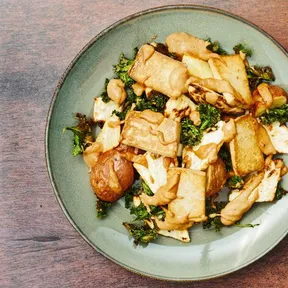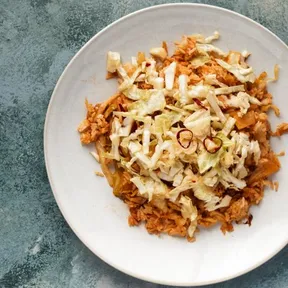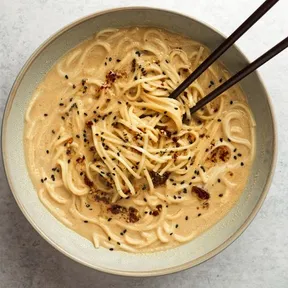
Asia - Meera Sodha
Meera Sodha has become known for her cookbooks featuring Indian dishes in particular. In 2015, the Dutch version of Made in India ️ will be released. In it Meera Sodha brings Indian dishes back to the core. Made in India is not a vegetarian book, and includes dishes with meat and fish. In 2017, Puur India ️ will follow, with vegetarian recipes for every day.
With Asia in 2020 follows a book by Meera Sodha where the focus is no longer just on India, but all of Asia. These recipes are not necessarily authentic, which in this case is not a bad thing as far as I am concerned total . The dishes are all flavorful, but with ingredients much more readily available. Like Pure India, Asia is also a vegetarian cookbook, with many dishes being vegan by themselves, or having an vegan option. However, this is not true of all recipes.
Asia is a 304-page book with 120 recipes. The book is of good quality and the accompanying photographs are nice, sharp and not too busy.

Curious about Asia from Meera Sodha. Check out the book at one of the partners of Plantproef
What's so great about Asia from Meera Sodha?
"Meera Sodha may count itself among the greats when it comes to writing cookbooks" - Jonah Freud, Het Parool
Of course, there are an awful lot of cookbooks available, as well as more than enough that are based on Asian cuisine. So what makes Asia so special? What are Jonah Freud's words of praise in Het Parool ️ based on?
Meera Sodha grew up in the United Kingdom, but has Indian roots. When Meera Sodha was growing up, Indian ingredients were not available or difficult to obtain in England, so her mother tried to prepare Indian dishes with common ingredients anyway. In addition, her parents also lived in Uganda for a time, so some Ugandan influences can also be found. Meera Sodha has carried on her mother's cooking style, broadening the influences in Asia. In addition to Indian and Ugandan influences, you can see in Asia, for example, dishes that are clearly based on Chinese, Japanese and Korean cuisine.
Classification
The book is divided into 11 chapters. Partly the chapters are based on type of dish, such as snacks, salads, and curry's, but partly also by ingredient. These chapters feature the relevant ingredients in the lead. For example, there is a chapter for tofu, with 8 unique tofu recipes and 1 tempeh-recipe. The chapter is preceded by an introduction about tofu, what types there are, and why she also added a tempeh-recipe (tempeh is not technically a tofu) to the chapter. Other chapters starring an ingredient are also preceded by further information.
One of the chapters is called "flavorings." These are not complete dishes, but recipes to serve with other dishes. These include homemade vegan mayonnaise, Szechuan chili oil, as well as ketjap manis and carrot atjar.
Alternative classification
In addition to the standard table of contents, Meera Sodha in Asia offers an "alternative format." This format includes a selection of dishes based on theme, such as quick meals, tasty as breakfast and from stock. Also nice is that it provides suggestions for seasonal dishes. That again makes cook with the seasons a little easier.
ingredients
As far as I am concerned, Meera Sodha is the queen of Asian fusion cuisine, and although fusion sometimes has a negative connotation, in this case I only mean it in a positive way. She knows with ingredients that are common in Western Europe. For example, she has a dish Ben-ben Noodles, inspired by Chinese Dan-dan Noodles ️. Instead of pickled mustard cabbage leaves(suimi ya cai ️), Meera Sodha simply uses pickle. The result is an incredibly delicious bowl of noodles.
The vast majority of recipes contains ingredients that is readily available. Some ingredients are somewhat less readily available in the supermarket, and you will have to visit the toko for those. This applies, for example, to gochujang. Although this is increasingly available in the supermarket, it is still advisable to go to the toko for this. There, the quality of gochujang is often better, and you can taste that.
How hard is it?
Meera Sodha has already shown with Made in India and Pure India that she can make authentic dishes very accessible. That same accessibility can be found in Asia. Most of the dishes are certainly not complicated, although sometimes things can get a little laborious. This is true, for example, of the *Katsu curry with eggplant and pickled radish*.
What's tricky about Asia is that it doesn't say how long it takes to prepare dishes. Now sometimes this is also hard to estimate, especially if a lot of vegetables need to be cut, but it does sometimes cause food to be ready later than I had planned.
Favorite dishes
There are an awful lot of very delicious dishes in Asia from Meera Sodha , which makes choosing difficult. Below is a small selection.
- Potato dosa with peas-coconut chutney. This dish reminds Meera Sodha itself of rösti, and me too. In Mumbai, this is called a potato dosa, and Meera Sodha's version is also recognized as such. Either way, this spiced potato cookie is worth making once - or more often. Personally, when I always worked at home during Corona, I had a period when I ate it as breakfast. I skipped the dwarf coconut chutney then, although it tastes super with it.
- Gado gado with celeriac, tofu and kale. This dish transforms simple ingredients such as celeriac and kale into a delicious Asian meal. The oven does most of the work, and the accompanying peanut sauce is very easy to make yourself. That peanut sauce is also worth a mention on its own. You make it in no time with a blender or hand blender. The recipe for Gado gado at Plantproef is inspired by this recipe .
- Nasi Goreng with Brussels sprouts. Also in this recipe you use vegetable which is very common in the Netherlands to include in a dish with Asian flavors. In this case, Brussels sprouts are used to make nasi goreng. By preparing the brussels sprouts in 2 ways, you can add a lot to the dish without making it boring. By the way, you can also replace the Brussels sprouts with green cabbage, as I did in this recipe.
- Braised tofu with honey, soy sauce and ginger. This page has gotten a little dirty in my copy by now. I like it so much that I make it regularly, and then sometimes some sauce accidentally splatters on the page. In this recipe , you add grated pear to your sauce, something you see a lot in Korean cuisine. Outside of pear season, I've also sometimes added grated apple. Apple doesn't melt through the sauce as well, but the taste was just as delicious. I have also omitted the fruit altogether. Then it is still a tasty dish, but you are really missing something.
- Katsu curry with eggplant and pickled radish. This dish is excellent for giving some extra validation to my statement that Meera Sodha is the queen of Asian fusion cuisine. It has ketchup in it! The first time I made the dish, I was a little surprised at having to add ketchup to the curry . It turned out to be a brilliant addition. The curry sauce is really very good and flavorful. And combined with breaded eggplant and pickled radishes, it is to die for.
Recommended?
As far as I'm concerned, this book really gets a resounding "yes." Where Simple from Ottolenghi is a doubt, and Flavour is also perhaps a bit less suitable for when you don't want to spend too much time in the kitchen, Asia from Meera Sodha really comes highly recommended. Most of the dishes are very accessible, without complicated ingredients and reasonably quick to prepare. The recipes are also all well described, which makes it a little easier. The most important thing, of course, is the taste. Every dish I have made from the book is delicious. If you like Asian flavors, this is a no-brainer.


